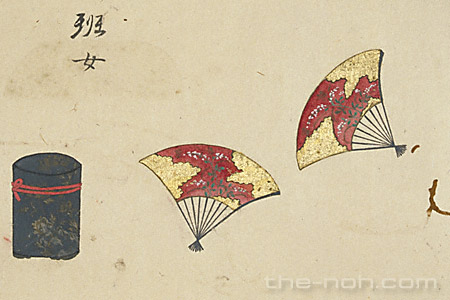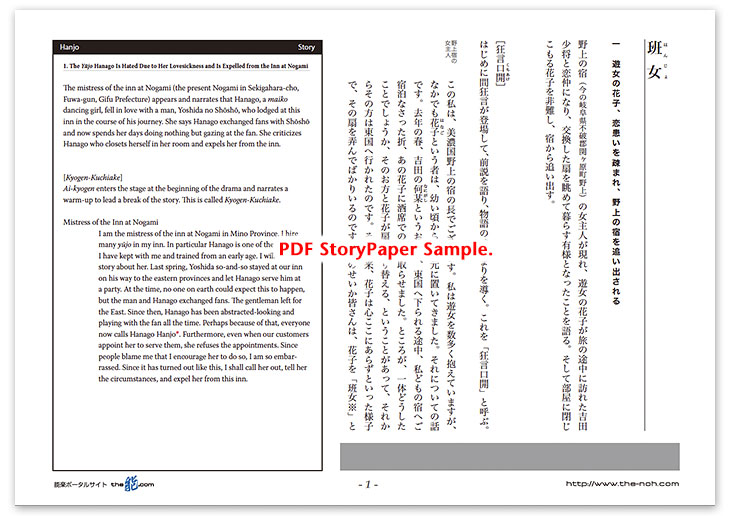
 Hanjo
Hanjo

![]()
Once upon a time, in an inn at Nogami in Mino Province (the present Nogami in Sekigahara-cho, Fuwa-gun, Gifu Prefecture), there was a yujo* whose name was Hanago. One day, a man named Yoshida no Shōshō lodged at the inn on his way to the eastern provinces. He and Hanago fell in love and exchanged fans before his departure as the token of his promise for the future. Since then, Hanago has spent days only looking at the fan and thinking of Shōshō. Since she stopped serving at banquets, the mistress of the inn at Nogami feels disgusted at Hanago who is now nicknamed Hanjo**. Hanago is finally expelled from the inn.
On his way back from the eastern provinces, Yoshida no Shōshō visits the inn at Nogami again. He is disappointed upon learning that Hanago does not live there anymore. Shōshō with broken heart goes back to Kyoto and visits Shimogamo Shrine in the woods of Tadasu to pray. At the shrine, Hanjo, in other words Hanago, appears by accident. After being expelled from the inn, Hanago became deranged Hanjo because of her love for Shōshō and in the end reaches Kyoto.
One of the retainers of Shōshō requests that Hanjo, who prays to the deity to make her wish for love come true, entertain them by acting out her madness, and she begins to become distressed as a result of this heartless request. With the fan which she exchanged with Shōshō as a remembrance, she laments his irresponsible words and dances while expressing her loneliness. The more she waves the fan, the crazier she becomes. Hanjo discloses her love which has become more passionate when they do not meet each other. She sheds tears in distress. Shōshō who was watching the dancing Hanjo pays attention to her fan and asks her to show it. In the dusk, Shōshō and Hanago see each other’s fans and recognize that they are the lovers they looked for. The lovers are pleased by the reunion.
*yūjo: A woman who is skillful at dance and music and entertains guests at parties. A type of dancer. (She might spend the night together with a guest.)
**Hanjo: Hanjo is Hanshōyo (or Ban Jieyu), who was a beloved wife of Emperor Cheng in the Western Han Dynasty in China. Since she was taken from the Emperor’s love by Zhao Feiyan, she composed a poem, “Enkakō (Verse of Resentment)” which likens herself to a summer fan, which is cast aside in fall. Since then, a discarded woman is called a fan in autumn. This piece sets the story around this Chinese legend; Hanago was called after the Chinese lady as she misses her lover separated by a long distance and spends her days gazing upon the fan.
![]()
This is a piece filled with a romantic atmosphere, which describes the prostitute Hanago’s love with all her heart through a fan.
The chanting expresses her fine sentiment and the dance and movements reveal her obsessive love. Her emotion interlaced throughout the drama gives us a powerful impression. Although unlike a hiraki-mono, this piece does not require special skills of performers and is not ranked higher, this is a deep drama, which requires rich expressiveness.
Different from other stories of madwomen, which describe the separation from a child or a spouse, this drama expresses sorrow, loneliness, a pure heart, and finally a joy of the reunion of a woman who has been distantly separated from her lover. Various emotions of woman in love are described. This is a quite popular piece among women, presumably because it evokes their sympathy.
The title of the drama, Hanjo, is a nickname of the main character, which is named after a Chinese legend about a fan. It develops the emotional color of this drama deeper. The elaborately-designed fan, whose strong presence provides an outstanding stage effect, is also one of the highlights.
There is also a Kyogen play titled “Hanago”, which seems to be related with Hanjo. This eventually developed another drama in Kabuki as well.
STORY PAPER : Hanjo
Story Paper presents noh chant stories in modern speech, with story outlines, highlights and more using Adobe PDF format, which can print out and zoom in. Print out the pages and take them with you when you see the actual noh performance.

The copyright of Story Paper is held by the Noh.com. Story Paper is for individual use only. It is prohibited by the copyright law to distribute or publish printed-out Story Paper pages without prior consent. For more information, check the credit and disclaimer pages.



 [Hanjo : Story Paper PDF : 540KB
[Hanjo : Story Paper PDF : 540KB